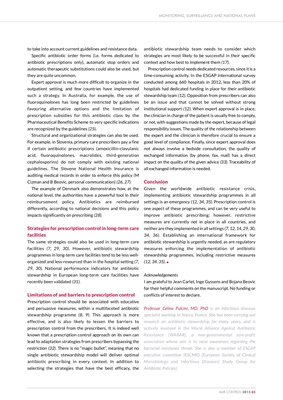
to take into account current guidelines and resistance data.
Specific antibiotic order forms (i.e. forms dedicated to
antibiotic prescriptions only), automatic stop orders and
automatic therapeutic substitutions could also be used, but
they are quite uncommon.
Expert approval is much more difficult to organize in the
outpatient setting, and few countries have implemented
such a strategy. In Australia, for example, the use of
fluoroquinolones has long been restricted by guidelines
favouring alternative options and the limitation of
prescription subsidies for this antibiotic class by the
Pharmaceutical Benefits Scheme to very specific indications
are recognized by the guidelines (25).
Structural and organizational strategies can also be used.
For example, in Slovenia, primary care prescribers pay a fine
if certain antibiotic prescriptions (amoxicillin-clavulanic
acid, fluoroquinolones, macrolides, third-generation
cephalosporins) do not comply with existing national
guidelines. The Slovene National Health Insurance is
auditing medical records in order to enforce this policy (M
Cizman and B Beovic, personal communication) (26, 27).
The example of Denmark also demonstrates how, at the
national level, the authorities have a powerful tool in their
reimbursement policy. Antibiotics are reimbursed
differently, according to national decisions and this policy
impacts significantly on prescribing (28).
Strategies for prescription control in long-term care
facilities
The same strategies could also be used in long-term care
facilities (7, 29, 30). However, antibiotic stewardship
programmes in long-term care facilities tend to be less wellorganized
and less-resourced than in the hospital setting (7,
29, 30). National performance indicators for antibiotic
stewardship in European long-term care facilities have
recently been validated (31).
Limitations of and barriers to prescription control
Prescription control should be associated with educative
and persuasive measures, within a multifaceted antibiotic
stewardship programme (8, 9). This approach is more
effective, and is also likely to lessen the barriers to
prescription control from the prescribers. It is indeed well
known that a prescription control approach on its own can
lead to adaptation strategies from prescribers bypassing the
restriction (32). There is no "magic bullet", meaning that no
single antibiotic stewardship model will deliver optimal
antibiotic prescribing in every context. In addition to
selecting the strategies that have the best efficacy, the
antibiotic stewardship team needs to consider which
strategies are most likely to be successful in their specific
context and how best to implement them (17).
Prescription control needs dedicated resources, since it is a
time-consuming activity. In the ESGAP international survey
conducted among 660 hospitals in 2012, less than 20% of
hospitals had dedicated funding in place for their antibiotic
stewardship team (12). Opposition from prescribers can also
be an issue and that cannot be solved without strong
institutional support (12). When expert approval is in place,
the clinician in charge of the patient is usually free to comply,
or not, with suggestions made by the expert, because of legal
responsibility issues. The quality of the relationship between
the expert and the clinician is therefore crucial to ensure a
good level of compliance. Finally, since expert approval does
not always involve a bedside consultation, the quality of
exchanged information (by phone, fax, mail) has a direct
impact on the quality of the given advice (33). Traceability of
all exchanged information is needed.
Conclusion
Given the worldwide antibiotic resistance crisis,
implementing antibiotic stewardship programmes in all
settings is an emergency (12, 34, 35). Prescription control is
one aspect of these programmes, and can be very useful to
improve antibiotic prescribing; however, restrictive
measures are currently not in place in all countries, and
neither are they implemented in all settings (7, 12, 14, 29, 30,
34, 36). Establishing an international framework for
antibiotic stewardship is urgently needed, as are regulatory
measures enforcing the implementation of antibiotic
stewardship programmes, including restrictive measures
(12, 34, 35). l
Acknowledgements
I am grateful to Jean Carlet, Inge Gyssens and Bojana Beovic
for their helpful comments on the manuscript. No funding or
conflicts of interest to declare.
Professor Céline Pulcini, MD, PhD is an infectious diseases
specialist working in Nancy, France. She has been carrying out
research on antibiotic stewardship for many years, and is
actively involved in the World Alliance Against Antibiotic
Resistance (WAAAR), a non-governmental non-profit
association whose aim is to raise awareness regarding the
bacterial resistance threat. She is also a member of ESGAP
executive committee (ESCMID [European Society of Clinical
Microbiology and Infectious Diseases] Study Group for
Antibiotic Policies).
MONITORING, SURVEILLANCE AND NATIONAL PLANS
AMR CONTROL 2015 65